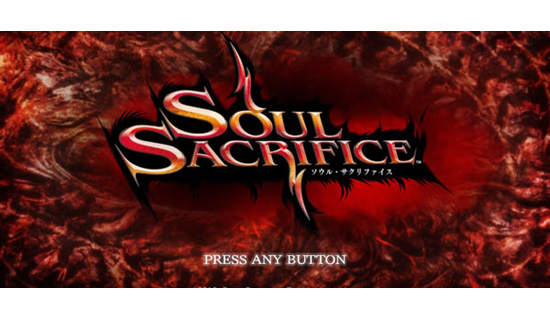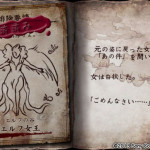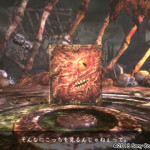Soul Sacrifice is what some refer to as a “Monster Hunter clone” (the game play is mission-based, involves killing a particular number of small monsters or a boss monster, and offers multi-player options in some form). Ever since Monster Hunter hit it big on the PSP a lot of major Japanese game companies have tried their hand at making a game that plays like Monster Hunter, to varying degrees of success (most of them failed pretty miserably). Even though I am a Monster Hunter enthusiast, I generally don’t pay too much attention to the clones past an initial investigation of what features they offer.
Why did this one get my attention? For starters, it was one of the earliest projects from famed former Capcom creator Keiji Inafune’s (best known for his spear-heading of the Mega Man series) new company Comcept. Even more so than that though, was the way that the game was presented upon its reveal. The artwork was of a very dark fantasy nature, a lot of it involving the depiction of sacrificing one’s own body parts for weapons to win a fight against an equally dark and grotesque looking boss monster. While some of this art was a little too off the deep end for me in general, it did intrigue me quite a bit. You mean someone was going to make a Monster Hunter clone that really offered a new dimension than just fighting monsters with weapons that you’ve upgraded from monster parts, so on and so forth? Alright, count me in!
Monster Hunter and its clones are not typically known for their great stories. The story in Soul Sacrifice is absolutely fantastic. You are a sorcerer who has been taken prisoner by another evil sorcerer named Merlin (there are a lot of references to Arthurian legend to be found here). He seems to make a practice of kidnapping people and using them as sacrifices to feed his own life force. Though this situation seems inescapable, before you are to be sacrificed you find a living book named Librom. You end up reliving a sorcerer’s memories through reading Librom’s contents, taking part in quests to kill monsters and gaining the power to eventually challenge Merlin himself. The story is definitely worth experiencing, so sharing any further details than this would be a huge disservice. Helping to flesh out the story is its storybook style presentation, extremely high quality voice acting (at least in the Japanese version), and exquisite music by none other than Yasunori Mitsuda.
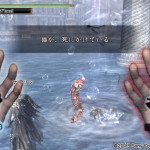 | 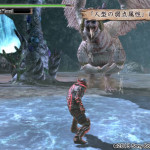 |
| The big decision: To save or sacrifice? | The thoroughly disturbing Harpy. It’s especially not unsettling when she sucks you up and chews on you. |
Another way in which Soul Sacrifice is surprisingly different from its predecessors is its weapon and combat systems. The main mechanic is represented in the name of the game itself: Each enemy you defeat represents a choice to be made. Do you save them or sacrifice them? When it comes to the small enemies, the decision is simply one of points: Saving increases your health level whereas sacrificing increases your magic power. Things get a bit more complex when we’re talking about the boss monsters. The same points apply for each choice, however now you’re dealing with saving or sacrificing an actual NPC who will often be begging for their life as you’re making this decision. Your choice will often decide whether they will be available to you as helper characters in other game modes, and will sometimes even have an effect on the story itself. Yet another dimension is introduced when deciding whether to save or sacrifice another player in the online multi-player mode. If you choose to save them you give up some of your own health in order to get them back in the battle. And if you choose to sacrifice them they are removed from the battle as a physical being, but help to create a spell that does massive area-wide damage. Players themselves are even faced with the decision to sacrifice parts of their own bodies in order to use a black rite that does a large amount of damage. Effects will remain for the rest of the battle, but can be reversed afterward if you have collected enough tears from Librom (they act as a currency of sorts).
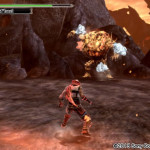 | 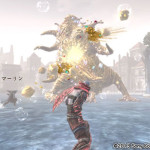 |
| One of the first bosses that you encounter: Jack-o’-Lantern. | The slime comes in a few different forms, but don’t worry…it’s always disgusting! |
Making the choice between being ranged or melee is not necessary either: you have 6 slots that you can fill with spells of your choice ranging from healing, ranged attacks, melee attacks, defensive, etc. With all of the choices of spell types, a few different fighting styles can be used during the same mission. This is a rather stark contrast to most of the Monster Hunter, in which you choose your weapon for a mission and you have to stick with it. Actual spells are obtained at the end of a mission, and are awarded depending on your rank. A higher rank is achieved through various feats such as not taking any/much damage, exploiting monster elemental weaknesses, breaking monster body parts, speedy completion, etc. If you know what a monster is weak to and how to beat it quickly going into a battle, it isn’t too difficult to get the highest rank. You then take your rewards and combine them to make stronger versions of spells. In lieu of armor you have various status boosting seals that are tattooed to your arm, and can be changed between battles to give you whatever character build you desire. This may all sound simple, but it requires a good deal of thought as to what spells you need as raw materials and what monster(s) they are obtained from. I often found myself a little lost in this, resulting in some spells not necessarily being as upgraded as they should have been.
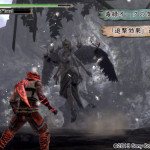 | 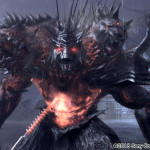 |
| The Elf Queen is one of my favorite monster designs in the game. | Cerberus here is another one of my favorites: Not so much disturbing as he is intimidating. |
As with most of these sorts of games, multi-player is a lot of fun. The selectable multi-player missions are not those found in the single-player game, but rather side missions called Avalon Quests. The game’s core systems actually introduce a lot of frustrations into multi-player though: It is not always possible to get the bonuses you want, or even the save/sacrifice decision on the boss that you want, since there are three other players to take into account. They may kill regular enemies quicker than you, or they may all decide to save when you want to sacrifice. There can only be one result for everyone, so majority rules. If nothing else, this is more of an encouragement to play with people that you know instead of random players. I didn’t play very much online due to lack of time, frustration at the points mentioned above, and just being so engaged in the single-player story that I didn’t really miss it. Similarly, I didn’t end up playing much of the additional missions/bosses that were later added to the game as free DLC.
I ended up looking at Soul Sacrifice as existing parallel to Monster Hunter. Though similar in its basic concepts, it feels so significantly different from so many of its predecessors that it takes on its own distinct identity. Its systems are simple enough to keep the interest of a casual player, but complex enough to allow the hardcore player to spend a lot of time fine tuning. Battles feel much more streamlined than Monster Hunter in general, which should greatly please those who can’t stand the undertaking that a typical battle in Monster Hunter can often be. Those who were horrified by the concept art actually don’t have much to be afraid of here either. A lot of the grotesqueness depicted there is not as present (or at least not as noticeable) in the actual game, though some of the monsters are still pretty disturbing looking. It is both more mature (the ability to use multiple types of spells in one battle add a new dimension to combat) and immature (since it uses single area arenas, it feels like they have a lot less life to them than your average area in Monster Hunter) than Monster Hunter. If you like your hunting games, you don’t have to choose: play them both!
